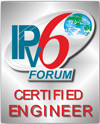
Certified Network Fundamental
Introduction
Build a foundation of networking knowledge in a real-world, multi-vendor environment. A strong foundation of basic networking concepts is fundamental to a successful career in information technology. Networking technologies underlie all IT activities and a strong comprehension of the hardware and protocols used to create networks is essential to future success.
In this training course, you will learn how to configure a workstation to connect to a network, analyze network traffic using a protocol analyzer, examine switch and router configurations, perform basic IPv4 addressing and subnetting, and research network security solutions. You will gain an understanding of basic network functions, standards, and protocols, to prepare you to tackle advanced networking skills.
Who should attend?
New IT professionals who want to learn the basics of a structured, layered approach to networking, including the fundamentals of network hardware and components, network protocols, IP addressing and subnetting, and various tools used in network monitoring and troubleshooting. Ideal candidates include:
- Entry-level and newly hired technical professionals, including PC support, help desk, and networking professionals
- Sales and marketing professionals looking to increase their ability to communicate with technical professionals and increase sales
- Technical professionals looking to strengthen core skill before pursuing advanced topics and certifications
What Will You Learn?
- Basics of layered network protocols and compare the two primary reference models: OSI and TCP/IP.
- Inspect a structured cabling system, including the proper use and installation of UTP and fiber optic cables.
- Configure a workstation to connect to a network.
- Ethernet operations and the use of VLANs by examining the configuration and operation of switches on a network.
- Spanning Tree operation as a method of eliminating broadcast storms on a switched network.
- Configure a Wi-Fi router for operation on a SOHO network, including security, SSID and Wi-Fi channel.
- Various IP addressing considerations, including binary to decimal conversion, dotted decimal notation, classful vs. classless addressing, private vs. public addresses, and the use of network masking
- Create a subnet for a small network, selecting the correct masks for various situations to accommodate the current number of hosts in each subnet and to also allow for future growth.
- Operation of various TCP/IP protocols on a network, including connectionless and connection-oriented communications using UDP and TCP, translation between private and public addresses using NAT, and support protocols such as ARP, DNS and DHCP.
- Router configurations to determine the function of various routing protocols, including RIP, IGRP, and OSPF, within and between networks.
- Various WAN technologies, including circuit switched solutions such as leased lines and packet switched solutions such as Carrier Ethernet, and determine the best WAN connectivity solution for a given corporate network.
- Use a protocol analyzer to capture and view network traffic, including e-mail, instant message exchanges, and web transactions.
- Basic network security implementations by testing the impact a router that has been configured as a firewall has on the flow of traffic through a network.
- Research the suitability of popular anti-malware suites for mitigating network security threats.
- Research Mobile Device Management (MDM) solutions to support BYOD deployments.
Prerequisites
- Computer knowledge would be advantage.
Duration
4 days
Training Approach
- This class covers both theoretical and practical knowledge.
- The practical classes are conducted in a laboratory environment.
- The participants will have hands on experience using the actual equipments.
- Quiz will have conducted during the class to test the knowledge of participants about some particular sub topics.
- Professional examination both theoretical and practical will conducted to test the participant’s knowledge towards end of the class.
- All the participants that passed the examination will be awarded certificate that endorsed by Global IPv6 Forum and WIDE Japan.
Course Content
The following is the outline of the course:
Introduction to Networking
- What Is Network Computing?
- Building Blocks of Networks
- Network Infrastructure: Media
- Network Infrastructure: Switches and Access Points
- Network Infrastructure: Routers
- Network Services
- Network Types
- Network Topologies
- Locating Network Resources: Peer-to-Peer Networking
- Locating Network Resources: Client-Server Networking
- Virtual Computing
- Cloud Computing
Network Standards
- Standards Organizations
- Example Standards Development Process
- OSI Mode Overview
- TCP/IP Model
Ethernet LANs
- NIC and MAC Addresses
- Ethernet Standards
- Ethernet Frame Structures
- Ethernet Equipment Types
- Ethernet Connectors
- Ethernet Performance Issues
Ethernet Switching
- Benefits of Switching
- Switch Installations
- Switch Operations Overview
- Switch Loop Problems
- Spanning Tree Protocol Overview
- Configuring Switches
- VLAN Overview
- Link Aggregation Troubleshooting
Physical Network Connections
- UTP Cabling
- Fiber Optic Cabling
- Wireless Connections
Wireless LANs
- WLAN Standards: IEEE & Wi-Fi Alliance
- WLAN Components
- SSID
- Wi-Fi Channels
- Wi-Fi Speeds Overview
- WLAN Security
- WLAN Performance Issues
- Module Review and Discussion Questions
Wireless LANs
- WLAN Standards: IEEE & Wi-Fi Alliance
- WLAN Components
- SSID
- Wi-Fi Channels
- Wi-Fi Speeds Overview
- WLAN Security
- WLAN Performance Issues
- Module Review and Discussion Questions
IP Addressing
- What Are Logical Addresses?
- Binary Numbering
- Dotted Decimal Notation
- Three Types of IP Addresses
- Classful Addressing
- Assigning IP Addresses
- Reserved Addresses
- Private Addresses
- Network Masking
- Classless Addressing
- Introduction to IPv6
IPv4 Subnetting
- Purpose of Subnetting
- Subnet Communications
- Subnet Mask Rules
- The Art of Subnetting
- The Science of Subnetting
- Calculating Subnets
- Four Key Addresses
- Implementing the Plan
- Subnetting Case Study
- Variable-Length Subnet Masking
Support and Management Protocols
- Address Resolution Protocol
- Dynamic Host Configuration Protocol
- Domain Name System
- Internet Control Message Protocol (ICMP)
- Internet Group Management Protocol (IGMP)
- Telnet
- Simple Network Management Protocol (SNMP)
- Legacy Protocols: NetBIOS and NetBEUI
TCP and UDP
- TCP and UDP Headers
- Connection-Oriented vs. Connectionless Communications
- Transmission Control Protocol
- User Datagram Protocol
- TCP and UDP Port Numbers
- Network Address Translation
Routing
- Routing Overview
- Logical Segmentation
- Static vs. Dynamic Routing
- Routing Decision Process
- Route Protocol Operation
- Common Routing Protocols
- Configuring Routers
- Module Review and Discussion Questions
Communications Protocols
- Electronic Mail
- Instant Messaging
- Voice over IP
- Unified Communications
Network Security
- Security Threats
- Threat Mitigation
- Developing a Security Plan
Wide Area Networks
- Evolution of WAN Technologies
- Sources of WAN Solutions
- Circuit Switched vs. Packet Switched
- Circuit Switched WAN Solutions
- Packet Switched WAN Solutions
- Internet WANs
- Module Review and Discussion Questions
Web Protocols
- Hypertext Transfer Protocol (HTTP)
- Secure Sockets Layer (SSL)
- Transport Layer Security (TLS)
- Remote Desktop Protocols
- File Transfer Protocol (FTP)
Emerging Networking Technologies
- Improved Wireless Technologies
- Enterprise Mobility
- Internet of Things
- Software Defined Networks
- Keeping Up with New Technology
